
22 minute read
The gas world meets in Washington DC
from IGU Magazine October 2018
by IGU
The global gas industry, policymakers, financiers and NGOs turned out in force for WGC 2018 against a backdrop of strong growth forecasts. By Mark Blacklock
Welcoming delegates IGU’s President for 2015-2018, David Carroll declared: “The global voice of gas has never been so crucial… and IGU has worked hard to make sure it is heard. Since WGC 2015 we’ve gone from COP 21, where gas was an afterthought, to a promising future with strong global growth outlooks.”
Global gas demand grew 3% in 2017 to 3,740 bcm, with China accounting for just under one-third of the growth, and the International Energy Agency (IEA) forecasts an average annual growth rate of 1.6% to 2023 and beyond. China is the third largest producer of gas but demand is outstripping domestic production and the country is expected to surpass Japan and Germany to become the world’s largest importer in 2019.
David Carroll, IGU’s President for 2015-2018, welcoming delegates.
On the supply side Russia, the number two producer, saw the largest increase of 46.3 bcm or 35% of the global increase in 2017. China’s production grew 11.3 bcm and Iran’s, the number four producer, 20.7 bcm, while the top-ranked USA increased production by a modest 5.2 bcm. However, IEA expects the USA to boost this significantly and account for almost 45% of the growth in global production to 2023.
To maximise the potential of gas, Carroll said, the industry needs to focus on cost-competiveness, security of supply and sustainability. The industry also has a role to play in alleviating energy poverty with more than 1 billion people in the world lacking access to electricity and 3 billion using wood, charcoal, crop waste or even dried dung for indoor cooking.
“Natural gas underpins our energy future. By every objective measure, there is no practical solution to resolving energy poverty that doesn’t include a significant role for natural gas,” said Mike Wirth, Chairman & CEO of Chevron. “Delivering on the future of energy will require massive private sector investments in sustaining
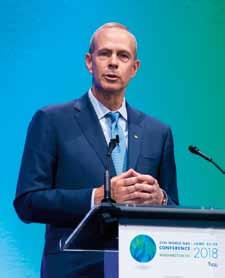
current energy supplies while at the same time identifying new solutions.”
These topics were comprehensively debated during the conference with much reference to the host country’s gas industry which has been transformed by the unconventional gas (UCG) revolution. From a scenario of declining conventional gas production and a growing need for imports little more than a decade ago, the USA has regained the position of the world’s largest gas producer and become a net exporter. Unconventional gas now accounts for two-thirds of US production.
“How has this transformation happened?” asked Rick Perry, the US Secretary of Energy, “in a word innovation”. A collaborative US research programme initially targeting coal-bed methane (CBM) and then shale and tight sands drove technological developments. Perry highlighted the use of drill bits with polycrystalline diamond cutters and the combination of horizontal drilling with hydraulic
c Mike Wirth, Chairman & CEO of Chevron: natural gas underpins our energy future. v Rick Perry, US Secretary of Energy: we want to share not just our energy but our energy success story.
fracturing which “helped unleash America’s natural gas revolution”.
“We now export to 30 countries,” continued Perry who said he wants to share “not just our energy but our energy success story” by exporting the technology and knowhow for other countries to exploit their unconventional gas resources.

Javier Iguacel, Argentine Minister of Energy: we can transform Argentina into a world-class energy supplier.

UCG focus on Argentina and Algeria
Canada, China and Australia rank after the USA as major unconventional gas producers. The focus on new players at WGC 2018 was on Argentina, where production is ramping up, and Algeria.
Javier Iguacel, the Argentine Minister of Energy told delegates that the country’s technically recoverable unconventional gas resources amount to 802 tcf (22 tcm) with the largest share in the Vaca Muerta shale play in the Neuquen Basin. “We can transform Argentina into a world-class energy supplier through massive and responsible development of Vaca Muerta,” he declared.
But memories of Argentina’s cutting of gas exports to Chile following its mid-2000s energy crisis are still raw. Having invested in pipeline connections with Argentina, Chile had to build two LNG import terminals to supply its gas needs. “We do not have a good story to tell because of our history in not complying with contracts,”
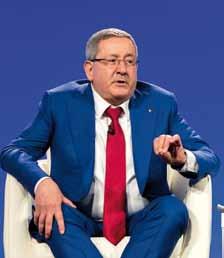
Abdelmoumen Ould Kaddour, CEO of Sonatrach: shale gas business is an exciting project for Algeria.
admitted Iguacel, “but there is a real change and what we have signed we will comply with.”
Iguacel said that 30 international and local companies have positions in Vaca Muerta, with five projects in full development and 25 in the pilot phase, and that costs are coming down although he wants to bring more service companies to Argentina to increase competition. The government subsidises new gas production above a set base level by guaranteeing a price of $7.5 per mmBtu, falling to $6 by 2021, but has been slow in paying producers.
Overall, Argentina imported 24% of its gas in 2017 by pipeline from Bolivia and as LNG, but demand is highly seasonal and peaks in winter when imports reach 40%. In the longer term there is still likely to be a winter import requirement. Increased domestic production will allow exports in summer by pipeline with LNG following. “We are working to develop export liquefaction facilities in two-to-three years in Bahía Blanca,” said Marcos Browne, Executive Vice President Gas & Power with YPF.
Algeria ranks just behind Argentina in terms of unconventional gas resources, which are estimated at 707 tcf (20 tcm). “We are committed to satisfying the needs of the local population and secondly to exporting,” said Abdelmoumen Ould Kaddour, CEO of Sonatrach, who pointed out that Algeria’s domestic gas demand has doubled since 2000. To meet this growing domestic demand and to maintain exports, Algeria plans to amend its hydrocarbon law in a bid to attract more foreign investors and is implementing a long-term development strategy for its unconventional gas resources.
“The shale gas business is certainly an exciting project for Algeria,” continued Ould Kaddour, while acknowledging the need to win over the general public by demonstrating that the technology is safe and will create jobs. Water use is a key issue and drove protests in 2015 against Algeria’s exploratory shale gas wells. Reusing produced water would help address this but would require significant investment in storage and treatment facilities.
Overall, Ould Kaddour said that Sontrach is investing $10-12 billion a year in the gas industry and highlighted the transport sector. “Getting gas from where it is produced to where it is consumed is the biggest challenge we

Daniel Yergin, Vice Chairman of IHS Markit and an IGU Wise Person: a big question for discussion is getting the infrastructure built that is needed to get gas to markets.
face,” he declared. Indeed, this was a major theme of WGC 2018.
Building infrastructure
“A big question for discussion is getting the infrastructure built that is needed to get gas to markets and support global LNG development,” said Daniel Yergin, Vice Chairman of IHS Markit and a member of IGU’s Wise Persons Group. He was echoed by Stanley Chapman, Executive Vice President & President of US Natural Gas Pipelines at TransCanada: “Simply having a strong resource base is not enough; we need to build infrastructure”.
A key factor in building infrastructure is to make not just a business case but also a social case by reaching out to all stakeholders. “We need to create an emotional connection between people and energy and we need to start talking about energy as if we are proud of it,” said Al Monaco, President & CEO of Enbridge.


Al Monaco, President & CEO of Enbridge: we need to create an emotional connection between people and energy.
Declaring that pipelines are under siege, Monaco continued: “If we are to seize the natural gas opportunity we have to acknowledge that public opposition and we need to work to build public trust by exceeding regulatory standards – not just meeting them – and really understanding community concerns before designing a project.”
Commissioner Robert Powelson of the US Federal Energy Regulatory Commission (FERC) highlighted the unintended consequences of objec

tions to new pipelines in the US northeast, which resulted in a gas shortage, greater use of oil and coal and consequently higher emissions during the past winter. “It’s sad that we had to burn two million barrels of oil to keep the lights on,” he said. “We have to get that gas to market.”
Geopolitics is also a major factor making pipeline development more difficult said Tatiana Mitrova, Director of the Energy Centre of the Moscow School of Management Skolkovo. Indeed, geopolitics directly impacted WGC 2018. There was a very small Russian turnout after Gazprom’s CEO Alexey Miller was placed on a new US sanctions list in April 2018, while sanctions meant Iranian reprentatives could not attend at all.
Mitrova singled out the case of NordStream 2, designed to double the direct pipeline capacity between Russia and Germany to 110 bcm/year. Poland and Ukraine have objected to losing transit revenues (although Belarus has not), while US President Trump has said it would make Germany “captive” to Russia.
c Tatiana Mitrova, Director of the Energy Centre of the Moscow School of Management Skolkovo (left) confers with Coby van der Linde, Director of the Clingendael International Energy Programme and an IGU Wise Person, during a break between sessions.
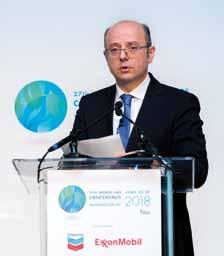
Parviz Shahbazov, Azerbaijan’s Minister of Energy: energy security includes the diversification of gas transport means.
Part of the answer, said Mitrova, is “greater diversity of supply which helps to ease geopolitical pressure”.
Péter Szijjártó, Hungary’s Minister of Foreign Affairs & Trade, and Parviz Shahbazov, Azerbaijan’s Minister of Energy, agreed, with Szijjártó calling for more south to north pipeline links in Europe and Shahbazov developing one. “Energy security also includes the diversification of gas transport means,” said Shahbazov. “Azerbaijan has recently taken decisive steps towards its integration into the international gas industry with the inauguration of the Trans Anatolian Pipeline (TANAP) to transport gas to the European market.”
TANAP is the central part of the Southern Gas Corridor connecting the Shah Deniz gas field in Azerbaijan to Europe through the South Caucasus Pipeline from Azerbaijan to Georgia (inaugurated in 2006 and now expanded), TANAP crossing Turkey from the Georgian border to Greece (inaugurated

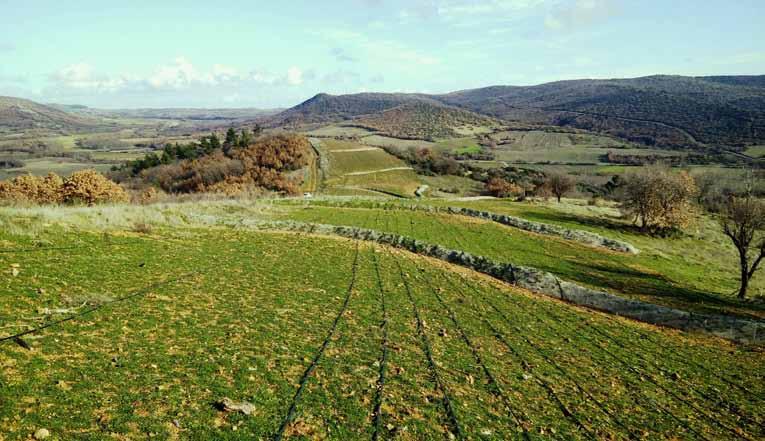



Yuval Steinitz, Israeli Energy Minister: Israel is going to export gas to the Arab world and beyond.
in June 2018) and the Trans Adriatic Pipeline running from the Turkish border through Greece and Albania to southern Italy, which is due to open in 2020.
Meanwhile, Israel is planning a deepwater cross-Mediterranean pipeline to open up a new supply route linking its gas fields in the Levant basin with Cyprus, Greece and southern Italy. “Israel is going to export gas to the Arab world and beyond,” said the country’s Energy Minister, Yuval Steinitz. Contracts have been signed to export gas to Jordan and Egypt using pipeline infrastructure originally built to export Egyptian gas plus a new direct link from Israel to Jordan. Steinitz said a final investment decision (FID) on the cross-Mediterranean pipeline is expected in 2019 and that in the longer term Israel is looking at building a liquefaction plant in Eilat to export LNG.
LN G and finance
The world’s LNG trade continues to grow strongly and increased 13.6% in 2017 to 293 million tonnes – mt (398 bcm) according to IGU’s latest World LNG Report, which was released during WGC 2018. Overall, 1,134 bcm (30.8%) of gas production was traded internationally in 2017 with 65% via pipeline and 35% as LNG.
LNG demand is expected to reach 500 mt by 2030, although there is likely to be a supply crunch in the first half of the 2020s before capacity catches up. “We have only seen 7 mt achieving FID in the last two years,” pointed out Stefan Vos de Wael, General Manager of the Global Integration Team at Royal Dutch Shell. There are many new projects in various stages of evaluation, notably in Canada and the USA, so the duration of the supply crunch will depend on the rate at which they reach FID.
IGU’s report confirms the changing dynamics of LNG markets. Spot and short-term trades in 2017 amounted to 88.3 mt, 30% of the market, up from 20% a decade ago. Together with less reliance on traditional long-term contracts, their terms are changing with alternative pricing mechanisms such as the US Henry Hub (although oil-indexation still covers 70% of LNG trade as Patricia Roberts, Managing Director of LNG Worldwide, pointed out) and the removal of destination clauses, which prevent buyers from on-selling LNG to third parties.
“Buyers increasingly need more flexible contracts to face competition

Patricia Roberts, Managing Director of LNG Worldwide (centre) introducing the panel for a keynote session with (from left to right): Seung-Il Cheong, President & CEO of KOGAS; Jack Fusco, President & CEO of Cheniere Energy; Charif Souki, Chairman of Tellurian; and Peter Coleman, CEO & Managing Director of Woodside Petroleum.
from other fuels such as renewables,” said Seung-Il Cheong, President & CEO of KOGAS.
“We are listening to the buyers,” answered Peter Coleman, CEO & Managing Director of Woodside Petroleum, “and 20-year contracts are now no longer the norm. We are seeing more and more 10-15 year contracts and even three years. There is flexible supply in the market now, the pricing points are there and I can sell LNG on any basis you want provided it’s a predictable basis.”
Coleman said he was in favour of an ending of oil-indexation. “The sooner the better…LNG should be able to stand on its own feet and trade alone,” he declared. Charif Souki, Chairman of Tellurian agreed: “I really don’t think that the indexation to oil will last much longer.”
However, changing contract terms have implications for the financing of LNG projects.
“As volatility of revenue or cash flow increases both your debt and equity are going to cost more and that will flow through the value chain,” warned Roberto Simon, Managing Director, Head of Natural Resources & Infrastructure, Americas with Société Générale. But he was confident that “there is an abundance of capital in the market”, stressing that “it is important to have clear regulations and guidelines; as a lender the thing we hate most is uncertainty”.
“If you come up with a valid business model that is sustainable you can get finance,” said Tellurian’s Souki, adding “you have to keep taking cost out not just in the liquefaction sector”.
And long-term contracts still have a role to play in LNG business models, said Chevron’s Wirth. Saad Sherida Al-Kaabi, President & CEO of Qatar Petroleum agreed: “Not many projects are going to be able to go to FID relying on just spot markets. Long-term contracts underpin long-term projects.” He added that he expected FID to be reached by the end of 2019 for the three LNG trains needed to boost Qatar’s annual export capacity to 100 mt.
Qatar has a high-grade investment rating despite the blockade maintained since June 2017 by Bahrain, Egypt, Saudi Arabia and the UAE (although, interestingly, pipeline gas exports from Qatar to the UAE have continued as Al-Kaabi pointed out). Non-investment grade emerging markets face problems in raising finance.
“If we say there is an abundance of capital it is not uniform. Debt and capital markets don’t have a lot of appetite for some countries,” said Société Générale’s Simon.
“How can small countries that are under investment grade make an investment case?” asked Omar Mithá, CEO of Mozambique’s ENH. “I think the way out is to create an anchor project to export and that will provide a government take to finance other things.”
This is also where export credit agencies and multilateral financial institutions can step in, and project finance is often used to mitigate sovereign risk. Although the World Bank will stop oil and gas upstream financing in 2019, Lance Crist, Global Head, Natural Resources at the Bank’s International Finance Corporation (IFC) said there are certain exemptions for the poorest countries but that, “our focus is how to help developing countries better access energy markets”.
Integrated gas-to-power projects are one example and IFC helped finance Panama’s LNG import terminal and a combined-cycle gas-fired power plant as an anchor customer. “The terminal is larger than needed for the power plant and the surplus will supply other markets,” explained Crist. The LNG terminal received its commissioning cargo from Cheniere Energy’s Sabine Pass plant in June, just before WGC 2018, and the power plant was expected to start up at presstime.
Burgeoning US LNG supplies using the Henry Hub benchmark are changing the dynamics of the global trade. The USA was the second country to start LNG exports – from the Kenai LNG plant in Alaska back in 1969 – but was a small player until exports from Sabine Pass in Louisiana started in 2016. Production is ramping up and accounted for 29% of the global increase in supply in 2017.
“We have four trains in operation and three trains in various forms of commissioning,” said Jack Fusco, President & CEO of Cheniere, which is now the largest purchaser of natural gas in the USA. “Our construction has been way ahead of schedule and under budget.”

Tor Martin Anfinnsen, Senior Vice President for Marketing and Trading at Equinor (far right), presenting during a keynote session. With him are (from right to left): Ryan Lance, Chairman & CEO of ConocoPhillips; Maria van der Hoeven, Senior Fellow with the Clingendael International Energy Programme; Patrick Pouyanné, Chairman & CEO of Total; Bob Dudley, CEO of BP; and Saad Sherida Al-Kaabi, President & CEO of Qatar Petroleum.
Sabine Pass was joined by Dominion Energy’s Cove Point plant in Maryland in March 2018 and Cheniere’s second plant in Corpus Christi, Texas will start up in 2019. Also due to start up are Cameron LNG, Elba Island LNG and Freeport LNG, which will see the USA leapfrogging Malaysia, Nigeria, and Indonesia to become the number three producer with 71 mt of capacity by 2020. A host of other export projects are in various stages of evaluation – just two of these, NextDecade’s Rio Grande and Tellurian’s Driftwood would add 53 mt – and the USA could be number one by the mid-2020s.
Meanwhile, Australia, which accounted for 34% of the global increase in supply in 2017, will overtake Qatar as the largest LNG producer at the turn of the year and will have 87.6 mt of capacity on stream by the end of 2019.
In terms of demand, the Asia-Pacific region accounted for three-quarters of the increase in LNG imports and China alone for over a third. The role of natural gas in combating climate change by replacing more polluting fuels is driving the growth in Chinese demand.
Sustainability
“Developing natural gas is an important measure for China to tackle emissions and improve air quality,” said

Li Yalan, Chair of Beijing Gas Group and IGU’s Vice President: China strongly supports the Paris Agreement. Li Yalan, Chair of Beijing Gas Group and IGU’s Vice President. “China strongly supports the Paris Agreement and the Chinese government has set a clear goal of making natural gas a major source of energy.” Gas currently accounts for 7% of China’s energy consumption and the share is forecast to reach 10% by 2020.
To help get there, China is expanding its pipeline transmission network, which will reach 100,000 km from the current 70,000 km by 2020, but more investment in storage is needed according to Li. “Storage capacity only accounts for 3% of annual consumption. We want to build storage capacity to cover 5%,” she said.
While China, the world’s largest energy consumer, supports the Paris Agreement, political opinion has shifted in the number two consumer and President Trump has announced the USA’s withdrawal. As Secretary Perry told
WGC 2018 delegates, “rather than regulation we seek to reduce emissions through innovation”. There were certainly many examples of such innovation presented during the conference, but there were also many voices saying the industry couldn’t do this on its own.
Darren Woods, Chairman & CEO of ExxonMobil, said the job of policymakers is to develop a constructive framework for dealing with climate change, and perhaps more importantly, to get the international community to work in unison. “We supported the Paris Agreement for this reason. It explicitly recognised that dealing with climate change is a global challenge and it demands a global response. Without a concerted, coordinated approach, we hinder the ability to make realistic progress,” he said.
Patrick Pouyanné, Chairman & CEO of Total, agreed. “The best way is to act collectively and to act transparently,” he said, while Tor Martin Anfinnsen, Senior Vice President for Marketing and
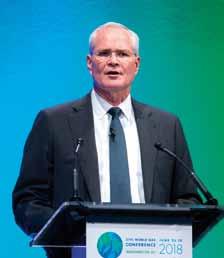
Darren Woods, Chairman & CEO of ExxonMobil: climate change is a global challenge and it demands a global response.
Trading at Equinor, declared: “A sustainable decarbonised energy system will have to be supported by policies on national and international levels.”
Those policies need to address the continued need for gas by fostering greater use of carbon capture and storage, biogas from agricultural and other waste and hydrogen. “Our economies need molecules and not just electrons,” pointed out Coby van der Linde, Director of the Clingendael International Energy Programme and an IGU Wise Person.
“The goal needs to be a partnership between gas and renewables,” said Klaus Schäfer, CEO of Uniper.
“We need to push the concept that gas is not a transition fuel but a steady state fuel,” said Marco Alverà, CEO of Snam. “We need to stop this cold war in Europe between molecules and electrons.”
Moreover, delegates were quite clear that it isn’t simply about carbon.
“Attention has been focused on CO 2 yet methane contributes one quarter of global air pollution today,” said Fred Krupp, President of the Environmental Defense Fund. “A core strategic challenge for this industry is to tackle methane emissions. We are going to launch a satellite to report on how much methane is going into the atmosphere.”
Work on MethaneSAT is well underway, with the goal to launch in late

Professor Mark Zoback of Stanford University (centre) introducing the panel for a keynote session with (from left to right): Rachel Kyte, CEO of Sustainable Energy for All; Ariel Yepez García, Energy Division Chief, Inter-American Development Bank; Omar Mithá, CEO of ENH; and Abdelmoumen Ould Kaddour, CEO of Sonatrach.
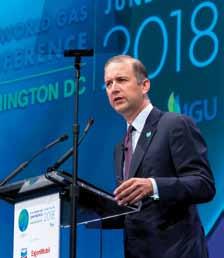
Marco Alverà, CEO of Snam: we need to stop this cold war in Europe between molecules and electrons.
2020 or early 2021, and its data will be freely available.
“In the UK emissions are down to 1894 levels and in the USA to 1990 levels due to greater use of gas to generate electricity,” said Bob Dudley, CEO of BP. “We need to make the case for gas to remove any doubts about its long-term benefits. To do this we need to control methane leakage.” His colleague Bernard Looney, Chief Executive, Upstream, pointed out that this is a win-win issue. “Every molecule that stays in the pipe is also a molecule you can sell. So containing methane is good for business as well as good for the environment,” he said.
“If we want to develop demand for gas we need to be efficient and continue to lower costs,” said Total’s Patrick Pouyanné. “Secondly, we must advocate for gas and tackle methane emissions taking into account the whole chain from production to distribution.”
Rachel Kyte, CEO of Sustainable Energy for All and Special Representative of the UN Secretary General, was blunt. “You have to fix your methane problem and fix it quick,” she said.
Kyte went on to point out that of the 1 billion people without electricity some 600 million live in sub-Saharan Africa where there is a major population movement to the cities. “We have to think about energy mixes where we can implement decentralised renewables in rural areas and densification of the grids in urban areas,” she said. “There is a very important role for gas but that’s going to require publicprivate partnerships.”
As regards population movements in Africa, Sonatrach’s Ould Kaddour highlighted immigrant flows from south to north which are putting major pressure on Mediterranean countries and will only intensify unless economies in the south are developed. “We need to have an international strategy to get more energy to these countries so they can stabilise their economies,” he said.
Handover
On the last day, the American team led by David Carroll looked back at the conference highlights and said farewell to delegates in a closing ceremony which included the presentation of IGU’s 2018 Global Gas Award (see pages 80-83). “I am really struck by the optimism in this industry; gas is back in a big way,” Carroll said, adding that he had been impressed by the WGC 2018
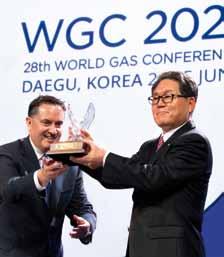
David Carroll hands over to IGU’s new President Joo-Myung (Joe) Kang during the closing ceremony.
Young Professionals Programme (see pages 70-72). “The future of our industry is in very good hands.”
Taking the floor, Joo-Myung (Joe) Kang declared: “It is a great honour for me to introduce myself as the President of IGU for 2018-2021. The Korean Presidency is fully committed to intensifying our collective efforts in support of a strong natural gas future that supports prosperity and improvement of the quality of life.” He was joined by Korea’s Minister of Trade, Industry & Energy, Ungyu Paik, who said: “At this critical juncture when natural gas is acting as a game changer we feel great pride but this comes with heavy responsibilities.”
The Korean triennium will culminate in the 28th World Gas Conference in Daegu in June 2021.
Mark Blacklock is the Consulting Editor of International Systems & Communications Ltd.










